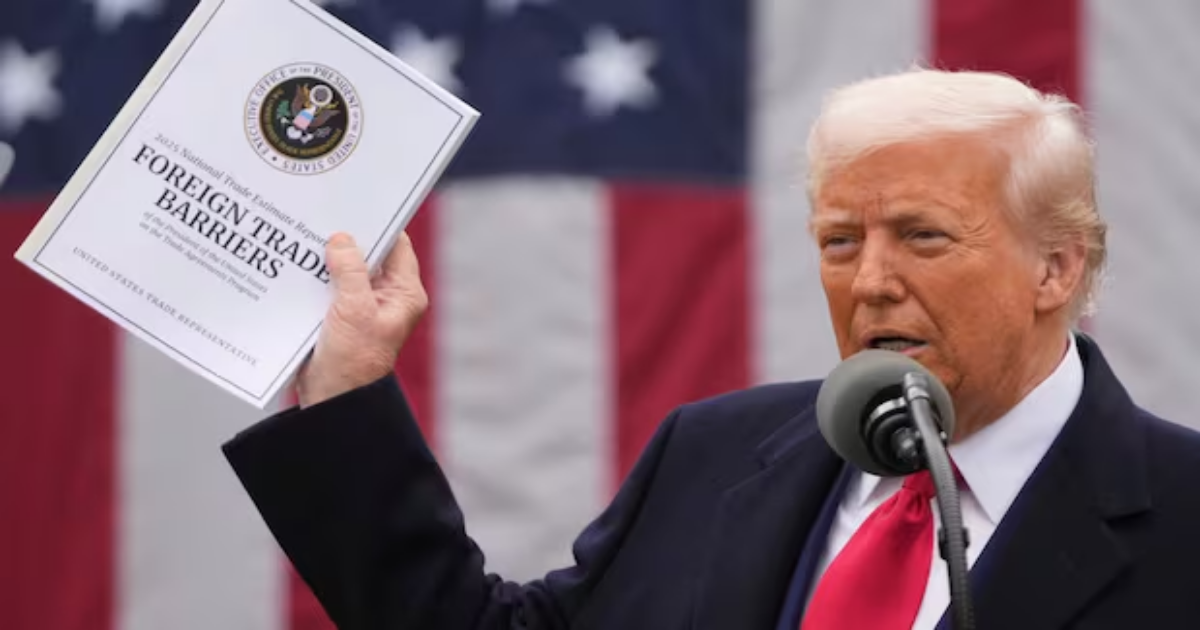U.S. President Donald Trump announced Wednesday his long-awaited plan to impose what he’s calling “retaliatory” tariffs on imports coming from dozens of countries — but the White House said there will be no more across-the-board levies applied to Canada than what has previously been announced.
Trump said however that he is going ahead with a 25 per cent tariff on “all foreign-made” automobiles as of midnight Wednesday, which could have severe implications for the Canadian auto sector.
The White House said that tariff rate will apply to Canadian-made passenger vehicles, but there is a caveat — it will only be levied on the value of all non-U.S. content in that automobile.
Trump also said he would apply “a minimum baseline tariff of 10 per cent” on all goods coming into the U.S., with rates higher than that for countries the president said have supposedly been more egregious about ripping off the Americans.
In a fact sheet disseminated to reporters after Trump’s announcement, the White House said Canada will not be subjected to that additional baseline tariff rate because the previously announced border-related tariffs will continue to apply instead.
Trump slapped a 25 per cent tariff on Canadian goods (and 10 per cent on energy) last month, supposedly in response to drugs and migrants coming into the U.S. across the northern border, but made some exceptions for importers who can prove the products they’re bringing in from Canada are compliant with the U.S.-Canada-Mexico Agreement (USMCA).

Prime Minister Mark Carney arrives outside the Office of the Prime Minister and Privy Council in Ottawa before Trump’s tariff announcement on Wednesday. (Justin Tang/The Canadian Press)
Liberal Leader Mark Carney, who paused his election campaign Wednesday to meet in Ottawa with his cabinet to craft a response, said Trump’s announcement has “fundamentally changed the international trading system.”
Carney said Trump preserved some aspects of the Canada-U.S. “commercial relationship” by holding off on deploying the full force of reciprocal tariffs on this country. But he said the tariffs that will now take effect on autos are a particular concern, and warned there may be more to come for other sectors.
Carney said the White House has signalled to Canada that there may be more U.S. tariffs at a later date on other “strategic sectors” such as pharmaceuticals, lumber and semiconductors.
“The series of measures will directly affect millions of Canadians,” Carney told reporters on his way into cabinet Wednesday.
“We’re going to fight these tariffs with countermeasures. We are going to protect our workers and we are going to build the strongest economy in the G7. In a crisis it’s important to come together and it’s essential to act with purpose and with force, and that’s what we’ll do,” he said.

Prime Minister Mark Carney, speaking from Parliament Hill on Wednesday, says Canada will act with ‘purpose and with force’ to fight new U.S. tariffs. President Donald Trump slapped new 25 per cent tariffs on foreign-made cars, but Canada was spared the 10 per cent baseline tariffs applied to many other countries.
Carney has already agreed with Trump to sit down right after this federal election and start the process of renegotiating a new, comprehensive economic and security relationship to bring this era of fractious relations to a close.
A 3-pronged approach
Trump is pursuing a three-pronged approach to tariffs as he tries to radically reshape the American economy.
There are the “reciprocal” tariffs that Trump imposed Wednesday on a whole host of other countries except Canada and Mexico.
Then there are so-called “section 232” tariffs that have already been levied on Canadian steel and aluminum and, as of midnight, will also be slapped on automobiles.
Those tariffs take their name from the section of a U.S. trade law that allows the president to impose levies on certain goods that are said to threaten “national security.”
And third, there are the border-related tariffs to punish Canada for what the president has described as an “emergency” drug crisis fuelled by fentanyl coming in from the north.
The White House said Wednesday if the drug and migrant “emergency” trade order is cancelled at some point, then the tariff on goods that do not comply with USMCA will fall from 25 per cent to 12 per cent.
Still, Trump singled out Canada for criticism when announcing the latest tariff regime, repeating his oft-cited falsehood that the U.S. somehow “subsidizes” this country by $200 billion a year. The U.S. trade deficit with Canada — which is largely driven by cheap oil imports — is much smaller than that.
“You gotta work for yourselves,” Trump said of Canada. “We subsidize a lot of countries, keep them going and keep them in business.”
“Our country has been looted, pillaged, raped, plundered by nations near and far, both friend and foe alike,” Trump said. “They rip us off, it’s so pathetic. Now, we’re going to charge.”
Sharp price increases feared
Trump said the tariffs are meant to “supercharge our domestic industrial base” and force companies to make more products in the U.S., but they also risk prompting a brutal economic slowdown as consumers and businesses will soon face sharp price hikes as a result of the new taxes.
It’s Trump’s latest broadside against Canada, its one-time ally and free-trading partner.
In the roughly 10 weeks he’s been president, Trump has been on a rampage against Canada, levying tariffs, spreading misinformation about the dairy sector, threatening the country’s sovereignty with near-daily “51st state” taunts and repeatedly saying the Americans need nothing from Canada despite trade data that shows that’s patently false.
Those persistent attacks and insults have damaged bilateral relations. Some Canadians are boycotting American goods, pulling travel plans to the U.S. en masse and booing the American national anthem at sporting events, actions that were thought unthinkable only a few months ago.
How to handle Trump, his tariffs and the takeover threats have also become the central issue of the upcoming federal election.
